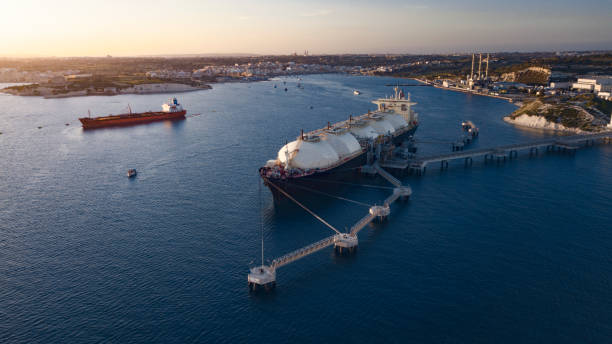China and India have led the rise in demand for LNG in Asia, but many other states are seeking to boost their use of natural gas for power in coming years, from South Asia to states like Vietnam and the Philippines
(AF) Global liquefied natural gas (LNG) trade increased to a record high in 2020, though that uptick was marginal amid demand destruction from coronavirus-induced restrictions, the International Gas Union (IGU) said last week in its newly released 12th annual World LNG Report.
Overall LNG trade increased to 356.1 million tonnes in 2020, a rise of some 1.4 million tonnes or 0.4% from the previous year, mostly driven by increased US and Australian exports, marking the seventh continual year of increased global LNG trade.
Figures from last year mark a contraction from 2019 when growth reached 40.9 million tonnes, or 11.5%. However, these numbers have to be put in context as LNG was one of the few commodities that actually increased in trade last year. Many had projected, before the onset of the coronavirus, for LNG global trade to expand as much as 8% during 2020.
The US – the third largest LNG exporter after Qatar and Australia – led the charge, accounting for all of the world’s new LNG capacity coming online for the period. Russia is the fourth largest LNG exporter, while President Vladimir Putin has set the goal of increasing the country’s LNG exports a national priority.
“The gas industry has held its own. Despite having to overcome many challenges in supply chain management, maintenance and commercial matters, secure and reliable supply of gas continued uninterrupted,” IGU President Joe Kang said.
Asia’s insatiable gas thirst
The second major takeaway from the IGU report comes from Asia. The region, home to top LNG legacy importers Japan, China, South Korea, India and Taiwan, accounted for 70% of all global LNG trade in 2020. The region also made up most of global LNG growth with the addition of 9.5 million tonnes of net LNG imports versus 2019. China drove the additions by providing 7.2 million tonnes of new net import demand.
Going forward, the Asia-Pacific region will continue to represent even more LNG market share amid China building out its LNG infrastructure. Beijing has mandated that gas make up 10% of the country’s energy mix by 2020, 15% by 2030, with further earmarks after that. However, given the country’s net zero by 2060 pledge, with emissions to be capped as early as 2030, increased gas earmarks could be forthcoming.
India is also increasingly turning to LNG to offset domestic gas production declines as well as helping the country of some 1.4 billion pivot away from dirty burning coal.
Currently, coal makes up as much as 70% of the India’s energy mix. Last year, New Delhi set a goal for the country to become a natural-based economy, increasing its share of the energy mix from just over 6% in 2020 to 15% by 2030 – no small feat. However, it’s still plausible given the country’s ongoing LNG infrastructure build-out and creative deal-making for term deals of various durations with a host of LNG producers.
Legacy LNG importers Japan, South Korea and Taiwan will likely see LNG demand growth stagnate over the balance of the decade, while South Asian nations Bangladesh, Pakistan and Sri Lanka, ramp up LNG procurement as they develop their LNG sectors and seek to shore up depleting gas reserves and replace coal fired power plants.
A similar dynamic is underway in the Philippines and Vietnam. The two Association of Southeast Asian (ASEAN) member states are staring down domestic natural gas depletion over the next few years, in large part due to the inability to develop offshore reserves in their own territorial waters in the South China Sea due to intervention from China.
Vietnam: 22 LNG projects, plus wind power
These gas shortages could cause brown and blackouts in more populated regions unless additional energy comes into play for both countries. Vietnam, for its part, has as many as 22 LNG-to-power projects in its upcoming Power Development Plan (PDP8) to be released within the next few months.
The IGU report also dampens a recent International Energy Agency (IEA) claim that the world should for all practical purpose pivot away from all fossil fuel production and development within the decade – a far cry from just eight years ago when the agency released a study called “The Golden Age of Gas.” However, the agency’s call for a marked decline and elimination of coal-fired power generation is a welcome call across the board.
However, it’s unrealistic, if not disingenuous, to call for a marked pivot away from cleaner burning natural gas just as most countries in the region are funding new gas and gas to power infrastructure to lower their respective carbon emissions.
Green hydrogen build-out which is gaining tremendous momentum in the EU and now in the US under President Joe Biden, will take more time to develop in Asia. This is particularly true for developing South and Southeast Asian countries since fossil fuel-hydrogen cost parity is still several years away.
Both wind and solar power has been slow to get off the ground as well in most Asian countries, except Japan and South Korea, though Vietnam’s renewables (solar and now onshore wind, and soon offshore wind) is now thriving, leading the region.
By 2021, Vietnam’s wind capacity is expected to reach 1-GW from 327-MW a year before. Hanoi also has ambitions to increase wind capacity to as much as 11-GW by 2025, cementing the country’s position as Southeast Asia’s renewables energy leader.
ALSO SEE:
There’s a new LNG king in town – and it’s not Japan
Perfect winter supply storm sends Asian LNG prices to record highs
























